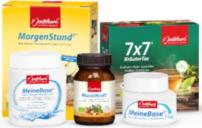Plant nutrients and a balanced acid alkaline balance are crucial for your success
By Roland Jentschura, master of oecotrophology
For athletes, both training and the required training success depend largely on a proper diet. Many athletes rapidly increase their intake of simple, “empty” carbohydrates for fast energy consumption and hope for fast muscle growth by protein. The body needs herbal nutrients for the metabolic process to function at its best. These vitamins and bioactive substances, minerals and trace elements determine the metabolic performance and the reaction rate e.g.of protein into muscle mass and tight tissues.
Better workout – alkaline
For a good workout with optimal provision of energy the metabolism needs antioxidants, vitamin B1, 2, 6,12, magnesium, calcium, potassium, sodium, iron, zinc, and many other micro nutrients. At the same time plant nutrients ensure that the lactate formed at high stress, doesn’t make the muscle too acidic. Muscle soreness, in the worst case blocks energy performance and leads to termination. In addition, the regeneration and construction process is unnecessary delayed and prolonged. Low pH values affect the structure and thus the stability of the muscle fibres, so that the risk of micro injuries (stiff muscles), fibre tears, tendon tears, and ligament tears rise. Herbal nutrients prevent that by buffering the formed acids, by carrying them away and in particular to support the kidneys in their excretion function.
Better regeneration – alkaline
Plant nutrients are essential components of the enzymatic regeneration process. Training provides the stimulus to increase performance, diet provides the “building blocks “, and supports the “master builder “, the enzymes of regeneration! Thus, to form muscles and tight tissues from protein, it needs always herbal nutrients. They also provide strong tendons, ligaments, bones and joints.
Recommendation: Increase of herbal nutrients supply
We can cover well with an 80% vegetable, herbal alkaline diet, the increased need for nutrients. These include foods like vegetables, salads, herbs, ripe fruit, and gluten free plants such as millet, quinoa, buckwheat, and amaranth. Since each plant has typical ingredients, the diet should be varied. It should be assured an increased demand of natural supplement with optimal bio availability. The other 20 % may be happy to consist of acidic, but important foods such as meat, fish, eggs, and cheese.

